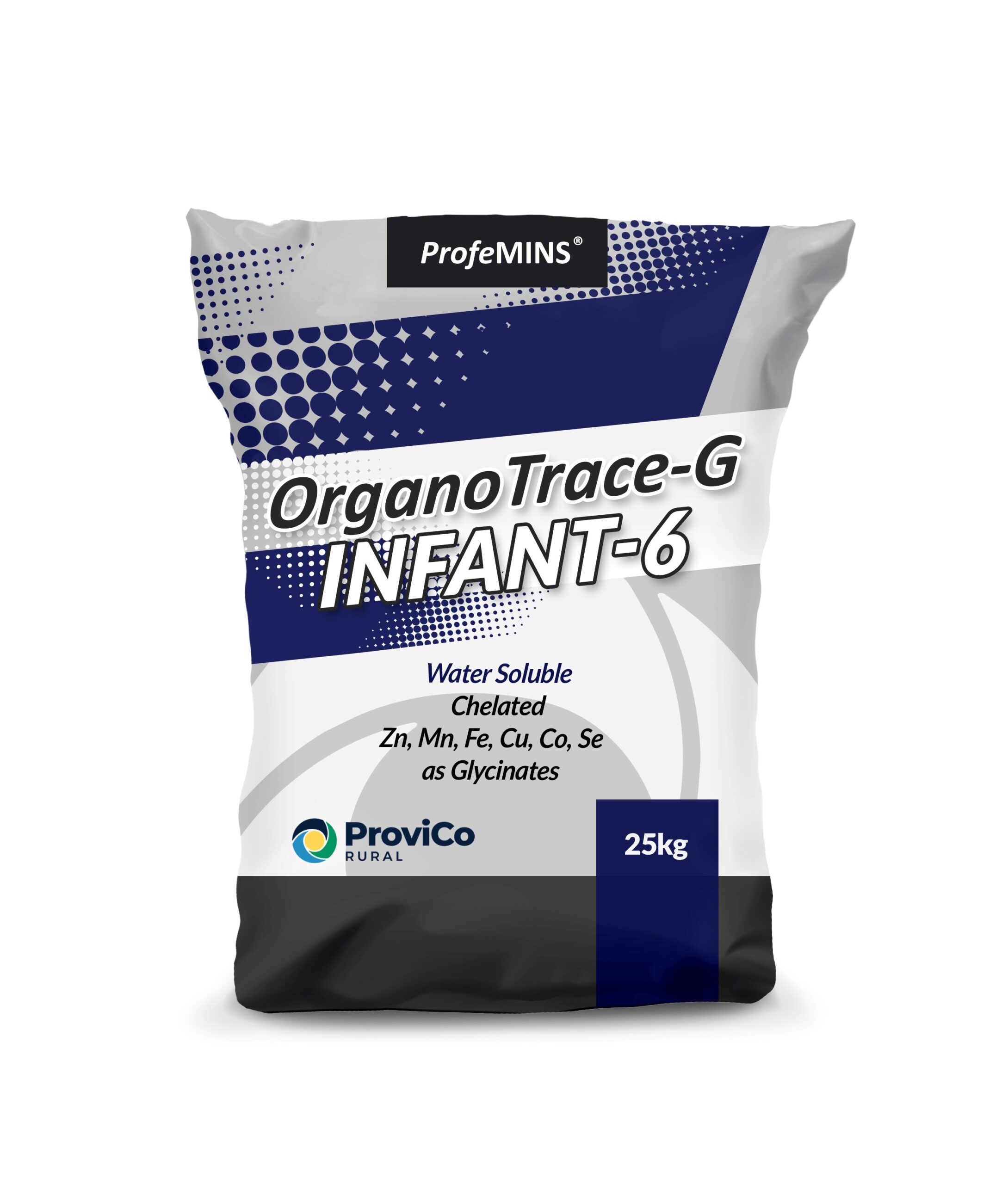OrganoTrace®-G Infant-6 WS
Water Soluble Organic Zinc, Manganese, Iron, Copper, Selenium and Cobalt (chelated to glycine) as a feed ingredient for infant livestock.
Available from Leading Rural Stockists
- Zinc (organic)
- Manganese (organic)
- Iron (organic)
- Copper (organic)
- Selenium (organic)
- Cobalt (organic)
A nutritional feed ingredient for infant livestock.
NEW ZEALAND
Do not use at the same time as any other Selenised fertiliser, prill or product and do not exceed the stated dose or frequency without consulting a veterinarian or nutritionist.
In sheep, liver levels of copper may be quite variable and consequently there is always as risk of copper poisoning occurring following supplementation in this species.
APPLICATION RATE
Only use in premixes for liquid feeding of infant ruminants.
FEEDING INSTRUCTIONS
| INFANT RUMINANTS | SMALL (LAMBS-KIDS-CRIAS) | 0.2 g/head/day |
| LARGE (CALVES-FOALS) | 0.4-0.6 g/head/day |
| 0.2g of ProfeMINS OrganoTrace-G INFANT-6 WS 19% contains: | 13.50mg organic Zn |
| 13.50mg organic Mn | |
| 10.00mg organic Fe | |
| 1.25mg organic Cu | |
| 0.10mg organic Se | |
| 0.02mg organic Co |
WITHHOLDING PERIODS
CATTLE
MEAT: Zero (0) days
MILK: Zero (0) days
SHEEP
MEAT: Zero (0) days
MILK: Zero (0) days
EXPORT SLAUGHTER INTERVAL (ESI)
Zero (0) days
Store in cool, dry place in original packaging and protect from humidity.
Keep opened packaging tightly sealed when not in use.
110170 25kg Bag l 40 bags per pallet
For further information call 0439 423 333
OganoTrace-G trace minerals are chelated to the amino acids glycine and are water soluble
OganoTrace-P Infant-6 is designed for liquid feeds where the bioavailability of trace minerals is critical for rapidly growing infant animals.
Trace minerals are chemically bound to a chelating agent or ligand, usually a mixture of amino acids or small peptides. This makes them more bioavailable and bioactive and provides the animal with a metabolic advantage that often results in an improved performance. They can therefore be included at much lower levels without compromising performance, thus minimizing nutrient excretion and environmental impact.
It is well known that trace minerals (Co, Cu, Fe, I, Mn, Mo, Se, and Zn, among others) are required for the normal functioning of basically all biochemical processes in the body. They are part of numerous enzymes and coordinate a great number of biological processes, and consequently they are essential to maintain animal health and productivity. Optimal nutrition, with adequate trace mineral levels, guarantees proper functions of the organism, among which the most important are structural, physiological, catalytic, and regulatory.
(López-Alonso Vet Science 2012)
Trace minerals have very specific but often roles as outlined in the table below.
| MINERAL | TRACE MINERAL FUNCTION |
| Zinc (Zn) |
|
| Manganese (Mn) |
|
| Iron (Fe) |
|
| Copper (Cu) |
|
| Cobalt (Co) |
|
| Selenium (Se) |
|
| Source: APVMA | |
| Deficiencies | It is difficult to realize the impact of insufficient trace minerals, as symptoms of deficiency or mineral unbalances may not always be evident. However, a slight deficiency of trace minerals can cause a considerable reduction in performance and production. (López-Alonso, Vet Science 2012) |
NIL
Got a Question?
Talk to one of our staff now,
call (03) 93943806


